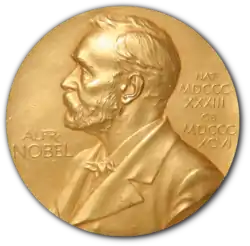Paul Greengard
Paul Greengard (December 11, 1925 – April 13, 2019) was an American neuroscientist best known for his work on the molecular and cellular function of neurons. In 2000, Greengard, Arvid Carlsson and Eric Kandel were awarded the Nobel Prize for Physiology or Medicine for their discoveries concerning signal transduction in the nervous system. He was Vincent Astor Professor at Rockefeller University,[2] and served on the Scientific Advisory Board of the Cure Alzheimer's Fund, as well as the Scientific Council of the Brain & Behavior Research Foundation. He was married to artist Ursula von Rydingsvard.
Paul Greengard | |
|---|---|
 Greengard in 2009 | |
| Born | December 11, 1925 New York City, U.S. |
| Died | April 13, 2019 (aged 93) New York City, U.S. |
| Nationality | American |
| Spouse(s) | Ursula von Rydingsvard (second marriage, in 1985) |
| Children | 2 (by his first marriage) |
| Awards | Nobel Prize for Physiology or Medicine (2000) NAS Award in the Neurosciences (1991) Dickson Prize (1978) Metlife Foundation Award for Medical Research in Alzheimer's Disease (1998)[1] |
| Scientific career | |
| Fields | neuroscience |
| Institutions | Rockefeller University |
Biography
Greengard was born in New York City, the son of Pearl (née Meister) and Benjamin Greengard, a vaudeville comedian. His older sister was actress Irene Kane, who later became a writer by the name of Chris Chase; she died in 2013, aged 89. Their mother died in childbirth[3] and their father remarried in 1927.[4] The Greengard siblings' parents were Jewish, but their stepmother was Episcopalian. He and his sister were "brought up in the Christian tradition".[5]
During World War II, he served in the United States Navy as an electronics technician at the Massachusetts Institute of Technology working on an early warning system against Japanese kamikaze planes. After World War II, he attended Hamilton College where he graduated in 1948 with a bachelor's degree in mathematics and physics. He decided against graduate school in physics because most post-war physics research was focusing on nuclear weapons, and instead became interested in biophysics.
Greengard began his graduate studies at Johns Hopkins University in the lab of Haldan Keffer Hartline. Inspired by a lecture by Alan Hodgkin, Greengard began work on the molecular and cellular function of neurons. He received his PhD in 1953 and began postdoctoral work at the University of London, Cambridge University, and the University of Amsterdam.[6][3] Greengard then became director of the Department of Biochemistry at the Geigy Research Laboratories.
After leaving Geigy in 1967, he worked briefly at the Albert Einstein College of Medicine and Vanderbilt University before taking a position as Professor in the Department of Pharmacology at Yale University. In 1983 he joined the faculty of The Rockefeller University.[6] Greengard was a member of the Board of Scientific Governors at The Scripps Research Institute. He was the acting chairman of the Fisher Center for Alzheimer's Research Foundation and served on the board of the Michael Stern Parkinson's Research Foundation, which later merged with The Michael J. Fox Foundation.[7] Both internationally renowned foundations support the research conducted in the Greengard laboratory at The Rockefeller University.
Research
Greengard's research focused on events inside the neuron caused by neurotransmitters. Specifically, Greengard and his fellow researchers studied the behavior of second messenger cascades that transform the docking of a neurotransmitter with a receptor into permanent changes in the neuron. In a series of experiments, Greengard and his colleagues showed that when dopamine interacts with a receptor on the cell membrane of a neuron, it causes an increase in cyclic AMP inside the cell. This increase of cyclic AMP, in turn activates a protein called protein kinase A, which turns other proteins on or off by adding phosphate groups in a reaction known as phosphorylation. The proteins activated by phosphorylation can then perform a number of changes in the cell: transcribing DNA to make new proteins, moving more receptors to the synapse (and thus increasing the neuron's sensitivity), or moving ion channels to the cell surface (and thus increasing the cell's excitability). He shared the 2000 Nobel Prize in Physiology or Medicine with Arvid Carlsson and Eric Kandel for his work on the central regulatory protein DARPP-32.[10]
Family
Paul Greengard had two sons from his first marriage, Claude and Leslie.[11] Claude Greengard holds a PhD in mathematics from UC Berkeley, and is the Founder of Foss Hill Partners. Leslie holds an MD from the Yale School of Medicine and a PhD in computer science from Yale University, and is a professor of mathematics and computer science at and director of the Courant Institute of Mathematical Sciences at NYU, a winner of the Steele Prize for a seminal contribution to research, a recipient of both a Packard Foundation Fellowship and an NSF Presidential Young Investigator Award, and a member of both the U.S. National Academy of Engineering and the U.S. National Academy of Sciences.
In 1985, Paul Greengard married internationally renowned sculptor Ursula von Rydingsvard, who has received numerous awards and grants, including two awards from the National Endowment of the Arts, a Guggenheim Fellowship, the Skowhegan Medal for Sculpture, and three awards from the American section of the International Association of Art Critics. von Rydingsvard is a member of the American Academy of Arts and Letters, and her artworks are among the permanent collections of the Museum of Modern Art, the Metropolitan Museum of Art, The Brooklyn Museum, the Nelson-Atkins Museum of Art, the National Gallery of Art and the Walker Art Center.[12]
Discrimination complaints
In February 2018, a federal jury in the Southern District of New York found The Rockefeller University liable for discrimination based on race and national origin which occurred in 2007 in the lab of, and under the supervision of, Greengard.[13][14]
Pearl Meister Greengard Prize
Paul Greengard used his Nobel Prize honorarium to help fund the Pearl Meister Greengard Prize, an award for women scientists. The award is named after his mother, who died during childbirth.[3] It was established in 2004 to shine a spotlight on exceptional women in science, since, as Greengard observed, "[women] are not yet receiving awards and honors at a level commensurate with their achievements."[15] The annual prize is awarded to an outstanding woman conducting biomedical research.[16]
Awards and honors
- Elected member of the National Academy of Sciences (1978)[17]
- NAS Award in the Neurosciences from the National Academy of Sciences (1991)[18]
- Golden Plate Award of the American Academy of Achievement (2002)[19]
- Honoris causa degree in Medicine, (September 2007) University of Brescia[20][21]
- Member of the Norwegian Academy of Science and Letters[22]
References
- "MetLife Foundation Awards for Medical Research in Alzheimer's Disease" (PDF). Archived from the original (PDF) on 13 October 2018.
- "Paul Greengard profile". Rockefeller University. Archived from the original on 2008-09-22. Retrieved 2008-09-28.
- "The Academy Remembers President's Council Member, Dr. Paul Greengard". The New York Academy of Sciences. 16 April 2019. Retrieved 9 May 2019.
- Dreifus, Claudia (September 26, 2006). "He Turned His Nobel Into a Prize for Women". The New York Times.
- Profile of Paul Greengard, nobelprize.org; accessed December 28, 2013.
- "Paul Greengard, PhD". The Michael J. Fox Foundation. Retrieved 9 May 2019.
- "The Michael J. Fox Foundation and The Michael Stern Parkinson's Research Foundation Join Forces to Accelerate Novel Ideas in Parkinson's Research". The Michael J. Fox Foundation. 30 June 2015. Retrieved 9 May 2019.
- Gellene D (14 April 2019). "Paul Greengard, 93, Nobel Prize-Winning Neuroscientist, Is Dead". The New York Times. Retrieved 9 May 2019.
- "Pioneering neuroscientist and Nobel laureate Paul Greengard dies at 93". Retrieved 14 April 2019.
- "Press Release: The Nobel Prize in Physiology or Medicine 2000". NobelPrize.org. 9 October 2000. Retrieved 9 May 2019.
- Clem Richardson (February 3, 2003). "A Nobel Patriarch 2000 Winner Head Of Talented Family". NYDailyNews.com. Daily News. Retrieved May 31, 2011.
- Smith, Harrison. "Paul Greengard, Nobel laureate who showed how nerve cells communicate, dies at 93". Washington Post. Retrieved 10 January 2021.
- "$2.25 Million Jury Verdict in Race/National Origin Discrimination Case Against Rockefeller University". 28 February 2018. Retrieved 9 May 2019.
- Fisher J (3 June 2007). "Bias Suit Slaps City Nobel Prof". The New York Post. Retrieved 9 May 2019.
- Betsy Hanson (December 17, 2004). "The Birth of an Award". Benchmarks. Archived from the original on February 7, 2012. Retrieved 2008-09-28.
- Dreifus, Claudia (September 26, 2006). "He Turned His Nobel Into a Prize for Women". New York Times. Retrieved September 26, 2006.
- "Paul Greengard". National Academy of Sciences. Retrieved 9 May 2019.
- "Daniel Giraud Elliot Medal". National Academy of Sciences. Retrieved 16 February 2011.
- "Golden Plate Awardees of the American Academy of Achievement". www.achievement.org. American Academy of Achievement.
- "Premi e riconoscimenti - Lauree Honoris Causa" (in Italian). Retrieved 27 January 2018.
- "Golgi Medal Award - Washington" (in Italian). Retrieved 27 January 2018.
- "Gruppe 7: Medisinske fag" (in Norwegian). Norwegian Academy of Science and Letters. Archived from the original on 27 September 2011. Retrieved 7 October 2010.
Sources
- Les Prix Nobel. 2001. The Nobel Prizes 2000, Editor Tore Frängsmyr, Nobel Foundation: Stockholm.
External links
- Paul Greengard on Nobelprize.org
 including the Nobel Lecture on 8 December 2000 The Neurobiology of Dopamine Signaling
including the Nobel Lecture on 8 December 2000 The Neurobiology of Dopamine Signaling - The Greengard Lab at The Rockefeller University
- Paul Greengard US Patents
